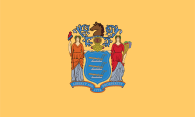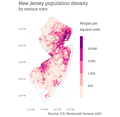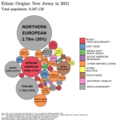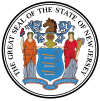Portal:New Jersey
The New Jersey Portal New Jersey is a state in both the Mid-Atlantic and Northeastern regions of the United States. It is the most densely populated state and at the center of the Northeast megalopolis. New Jersey is bordered to the northeast by New York state; on its east, southeast, and south by the Atlantic Ocean; on its west by the Delaware River and Pennsylvania; and on its southwest by Delaware Bay and Delaware. At 7,354 square miles (19,050 km2), New Jersey is the fifth-smallest state in land area, but with close to 9.3 million residents as of the 2020 United States census, it ranks 11th in population. The state capital is Trenton, and the state's most populous city is Newark. New Jersey is the only U.S. state in which every county is deemed urban by the U.S. Census Bureau. New Jersey was first inhabited by Paleo-Indians as early as 13,000 B.C.E. The Lenape were the dominant Indigenous group when Europeans arrived in the early 17th century, and they were subdivived into dialectal groups such as the Munsee, in the north, and the Unami and the Unalachtigo, elsewhere. Dutch and Swedish colonists founded the first European settlements in the state, with the British later seizing control of the region and establishing the Province of New Jersey, named after Jersey. The colony's fertile lands and relative religious tolerance drew a large and diverse population. New Jersey was among the Thirteen Colonies that supported the American Revolution, hosting several pivotal battles and military commands in the American Revolutionary War. New Jersey remained in the Union during the American Civil War and provided troops, resources, and military leaders in support of the Union Army. After the war, the state emerged as a major manufacturing center and a leading destination for immigrants, helping drive the Industrial Revolution in the U.S. New Jersey was the site of many industrial, technological, and commercial innovations. Many prominent Americans associated with New Jersey have proven influential nationally and globally, including in academia, advocacy, business, entertainment, government, military, non-profit leadership, and other fields. (Full article...) Selected article -
U.S. Route 1/9 Truck is a United States highway in the northern part of New Jersey that stretches 4.11 mi (6.61 km) from the eastern edge of Newark to the Tonnelle Circle in Jersey City. It is the alternate road for U.S. Route 1/9 that trucks must use because they are prohibited from using the Pulaski Skyway, which carries the main routes of U.S. Route 1/9. It also serves traffic accessing the New Jersey Turnpike, Route 440, and Route 7. The route is a four- to six-lane road its entire length, with portions of it being a divided highway, that runs through urban areas. From its south end to about halfway through Kearny, U.S. Route 1/9 Truck is freeway-standard, with access to other roads controlled by interchanges.
While the U.S. Route 1/9 Truck designation was first used in 1953, the roadway comprising the route was originally designated as an extension of pre-1927 Route 1 in 1922, a route that in its full length stretched from Trenton to Jersey City. U.S. Route 1/9 was designated along the road in 1926 and one year later, in 1927, this portion of pre-1927 Route 1 was replaced with Route 25 as well as with a portion of Route 1 north of the Communipaw Avenue intersection. Following the opening of the Pulaski Skyway in 1932, U.S. Route 1/9 and Route 25 were realigned to the new skyway. After trucks were banned from the skyway in 1934, the portion of Route 25 between Newark and Route 1 was designated as Route 25T. In 1953, U.S. Route 1/9 Truck was designated in favor of Route 25T and Route 1 along this segment of road. The portion of the truck route north of Route 7 is being rebuilt as part of a $271.9 million project that will replace the viaduct over St. Paul's Avenue. Construction, which started in late 2008, is expected to be complete in late 2012. Selected picture - Credit: Andrew Bossi Barnegat Lighthouse, colloquially known as "Old Barney", is located in Barnegat Lighthouse State Park on the northern tip of Long Beach Island, in the borough of Barnegat Light. It sits along the Barnegat Inlet. New Jersey news'Related portalsSelected biography -Francis Albert Sinatra (/sɪˈnɑːtrə/; December 12, 1915 – May 14, 1998) was an American singer and actor. Nicknamed the "Chairman of the Board" and later called "Ol' Blue Eyes," he is regarded as one of the most popular entertainers of the mid-20th century. Sinatra is among the world's best-selling music artists, with an estimated 150 million record sales globally. Born to Italian immigrants in Hoboken, New Jersey, Sinatra began his musical career in the swing era and was greatly influenced by the easy-listening vocal style of Bing Crosby. He found success as a solo artist after signing with Columbia Records in 1943, becoming the idol of the "bobby soxers". In 1946, Sinatra released his debut album, The Voice of Frank Sinatra. He then signed with Capitol Records and released several albums with arrangements by Nelson Riddle, notably In the Wee Small Hours (1955) and Songs for Swingin' Lovers! (1956). In 1960, Sinatra left Capitol Records to start his own record label, Reprise Records, releasing a string of successful albums. He collaborated with Count Basie on Sinatra-Basie: An Historic Musical First (1962) and It Might as Well Be Swing (1964). In 1965, he recorded the retrospective album September of My Years and starred in the Emmy-winning television special Frank Sinatra: A Man and His Music. After releasing Sinatra at the Sands in early 1966, Sinatra recorded one of his most famous collaborations with Tom Jobim, Francis Albert Sinatra & Antonio Carlos Jobim. It was followed by 1968's Francis A. & Edward K. with Duke Ellington. Sinatra retired in 1971 following the release of "My Way" but came out of retirement two years later. He recorded several albums and released "New York, New York" in 1980. (Full article...) Did you know? -
General imagesThe following are images from various New Jersey-related articles on Wikipedia.
TopicsQuality content
CategoriesThings you can do
For more information on how you can help, see the WikiProject New Jersey. Associated WikimediaThe following Wikimedia Foundation sister projects provide more on this subject:
Discover Wikipedia using portals |













































































